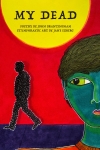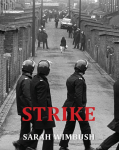
The first thing a reader sees is the cover: yellow, black, brown, green, and red; an eye is turned toward a figure in silhouette—etymphrastic art by Jane Edberg. Each poem is complemented by a vibrant illustration. The poems are set in the Midwest United States, Ohio, where trains are common in both rural and semi-urban towns. It’s a developed region, not far from a big airport, closer to Cleveland than to the small towns in the fiction of Sherwood Anderson and the poems of James Wright. One poem ‘Euclid Avenue’ suggests Cleveland. Like the eye on the cover, the speaker in the poems is observant. The poems are other-directed, and quiet, with settings that delineate the distance between the speaker and other people.
The poems are other-directed, and that other is someone seen for only a moment. In the first poem, ‘4:30 AM.’ the speaker notices someone has spread a blanket over his car, ‘with its busted headlight.’ He says, ‘I wonder where they are now/ that they do not need their blanket.’ In ‘Sunday Morning’ a man is sweeping a street. ‘The way he moves/ I think he has become/ his meditation.’ In ‘Blackbirds’ birds perch on a pole that runs along the side of a train car. ‘When it jerks to a start,/ they flock into the eucalyptus.’ In ‘Tanker’ a man appears to be waiting to cross train tracks, but when the train stops ‘he climbs the ladder/ of a tanker car/ and tags it/ with white spray paint.’ In ‘Just After Sunset’ the speaker, walking his dog, observes a commuter.
The man is staring
up the long street
for the bus
that is not yet here.
He’s unaware of Lizzy
and her need
for touch.
The poems are quiet. The speaker is thinking of his dead. ‘I can hear them almost/ telling me things/ that probably matter.’ In ‘Grandfather’ he sees a driver, a man, not staying in his own lane, but swerving into his lane. He speculates that the man is tired, having come off a long plane flight that landed at the close-by airport, from ‘A trip back home maybe,/ where everything he once knew/ has been lost.’ The poem concludes:
My grandfather,
a man who died five years
before I was born,
whispers to me
that the man found out
he will move on
to that next place much too early.
In ‘Euclid Avenue’ the speaker hears the dead ‘under the traffic noise/ of an early commute.’ He concludes, ‘I think they are trying/ to remind me of careless/ moments in my past./ Maybe they’re telling me of theirs.’
Lastly, the poems’ settings delineate the distance between the speaker and other people, and things such as, in ‘his Dawn,’ ‘the train/ that runs 100 feet/ from my front door.’ The poem ‘Light’ begins ‘I can walk from here to the library.’ Further into ‘Light’ the speaker says,
From the glass entrance door,
I cannot see the books.
A man who lives next to it
is watching me from his front door,
making sure that I don’t break in.
I wave to him, and he waves back
Of a palm tree hidden in ‘the canopy/of a sycamore’ he says, ‘I’m staring at it/ when my neighbor comes out/ to go to work and deadeyes me.’ Readers note the pun. In ‘Murmuration’ he watches a train engineer watching a flock of birds that have alighted ‘over the parking lot/ between my house/ and the trainyard.’ In ‘This Civility’ a hawk is ‘being chased by mockingbirds.’ ‘If I squint,/ I can see my dead/ flying about with them.’
In My Dead the landscape of the past coincides with the landscape of the present. Intimacy characterizes these spare, contemplative poems and their counterparts, Jane Edberg’s striking visuals. Each poem is its own world. It’s to the poet’s credit that he tells readers all they need to know and fills the silence with significance. John Brantinham’s My Dead is pure poetry.
Peter Mladinic 26th March 2024

